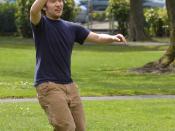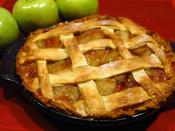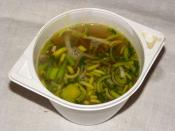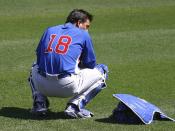When I was twelve, I stole a pack of gum from Wal-mart. It cost about a quarter, but it made me feel so bad that I couldn't sleep or eat or think about anything else except that pack of Big Red that I had stashed away in my sock drawer. Before I committed my heinous crime, I knew it was wrong, but I did not realize then that following reason would never lead a person astray though the heart can be so fickle. That is what Gary Soto discovered as he looked back to the day when he was six-years-old and stole an apple pie from the German Market. Through skillful use of diction and imagery, Soto takes the reader back to that fateful day where he ascertained that life furnishes opportunities to everyone, and learning from them is truly growing up.
The diction makes the reader feel the initial rapture Soto experiences when he takes the pie.
When Soto inspects the pies, from the pecan to the apple to the cherry to the "fat-faced chocolate,"ÃÂ the urge to seize one brings him close to tears trying to decide which will be the lucky one that he will hide behind his coffeelid Frisbee and out the door.
However, after he has devoured the delicacy, the sense that everyone knows what he did haunts him. The author uses diction and imagery here to show the paranoia he suffers after he has eaten the "wet finger-dripping pieces"ÃÂ of the "sweet and gold-colored"ÃÂ "slop."ÃÂ With his face "sticky with guilt,"ÃÂ Soto creeps around trying to avoid the driver of a car, who knows what he did, Mrs. Hancock, who knows what he did, and his mom, "at the Redi-Spud factory,"ÃÂ who knows what he did. The truth of the matter is that what appears to be obvious to one person may not be the true reality of the situation.
The imagery gives the reader a sense of loneliness and alienation by comparing his guilt to wanting to be by himself under his house. After Soto steals the pie and goes home, he decides "to crawl underneath [his] house and lie in the cool shadows listening to the howling sounds of plumbing."ÃÂ He crawls under there to listen for God, his father, his uncle, anyone who can relieve him of the remorse and penitence he undergoes in the aftermath of his transgression.
The diction gives the reader the impression that as a boy, Soto is disillusioned by his boredom and guilt. Because Soto starts out bored in the story, his view of his sin is skewed. After he eats the pie, his satisfaction blinds him when he realizes "that the best things in life [come] stolen."ÃÂ Nevertheless, at the end of the story, the diction evokes that Soto is finally seeing clearly after he "crawl[s] back to the light"ÃÂ and "[knows] that sin [is] what you took and didn't give back."ÃÂ When he emerges from beneath the house, not only is the sun shining on him, but the revelation about sin also enlightens him and marks his loss of complete innocence.
The purpose of the imagery is to make the reader feel the true distress that Soto is trying to suppress immediately after he steals the pie. "No one saw,"àhe "mutters"àto himself as he hurries across the street. There he sees "a squirrel nailed"æhigh on the trunk"à"of a yellowish sycamore"àwhich represents Christ dying for Gary's sins.
The imagery shows the barbarianism that takes over him after he has sinned, from when he "[claws] a chunk from the pie tin and [pushes] it into the cavern of [his] mouth"ÃÂ to when he will not share with Cross-Eyed Johnny although crust is falling from his mouth and his "teeth were bathed with the jam-like filling."ÃÂ Not only is he eating like an animal, he is hording all his food to himself without another thought for anybody else who might need it more, and he does not even feel bad about it.
Throughout this story, Soto goes from a greedy little boy who chooses to do what his heart says instead of using his reason, to a psychopath who thinks that everyone know what he has done, to a mature young man who recognizes that he needs to learn from his mistakes and the opportunities that life sets before him.




